|
San Diego's Historic Warehouse District
SOHO Saves on a Grand Scale
By Bruce Coons
After many years of work by all the parties involved we can finally see the results of the restoration, rehabilitation, relocation, compatible infill and reconstruction projects outlined in SOHO's precedent setting agreement with CCDC, the City of San Diego and the San Diego Padres. All of these projects have now been completed or are in the final stages of completion.
Today as you drive down J Street between 6th Avenue and 13th Street or walk the streets around the Ballpark and the Park at the Park you can see in play what architect Wayne Donaldson said in the beginning of this process that "the Historic Buildings will be like a string of pearls strung throughout the new developments, lending character and a strong sense of place to the new development ensuring its economic prosperity."
It was gratifying to hear international economic development consultant Donovan Rypkema tell the audience during his lecture at SOHO's Rancho to Ranch House weekend, that after touring this area that he thought that these projects within our agreement "were cutting edge in the country." He went on to say that we are using all of the elements about which he lectures, writes and advocates and was interested to see that we are trying some exciting new things as well.
(Scroll to view images)
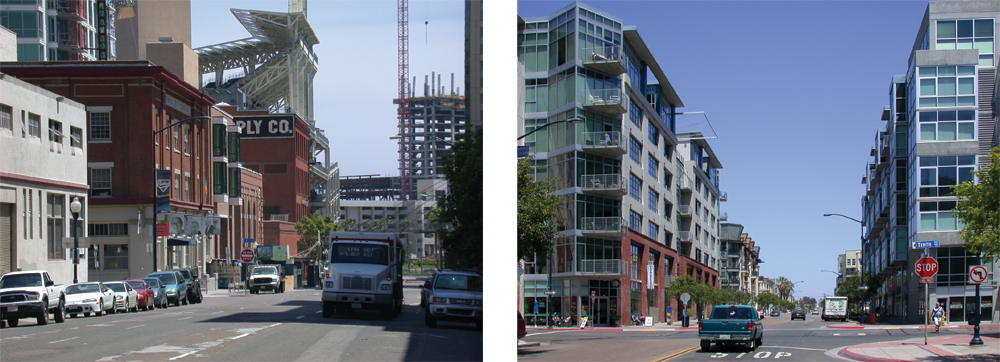
(Left) View down Seventh Avenue reveals historic buildings included in the district as well as new construction. (Right) 10th Avenue and J Street shows what happens to areas that are not subject to the guidelines in our agreement. Not very inviting, is it?
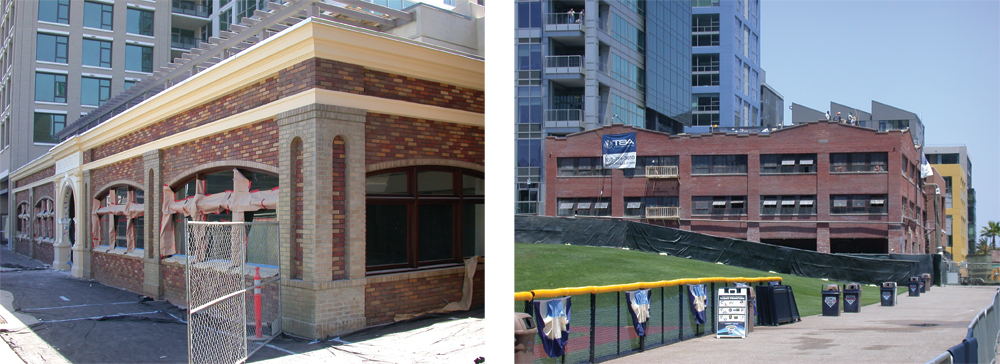
(Left) Levi Wholesale Grocery Co. (1927) - Final cleaning and fnishes being applied to the outstanding front of this neo classical building which was recently known as Kvass Construction. (Right) Showley Bros Candy Factory (1924) - Presently undergoing restoration and renovation. Our agreement called for moving this building two blocks east of its original site, to make way for the Park at the Park. Paint has been stripped to uncover the original brick exterior and the original signage will be recreated and installed including the shield shaped plaques with the logo of a bear eating a peppermint stick. This was the largest brick building to be moved west of the Mississippi.
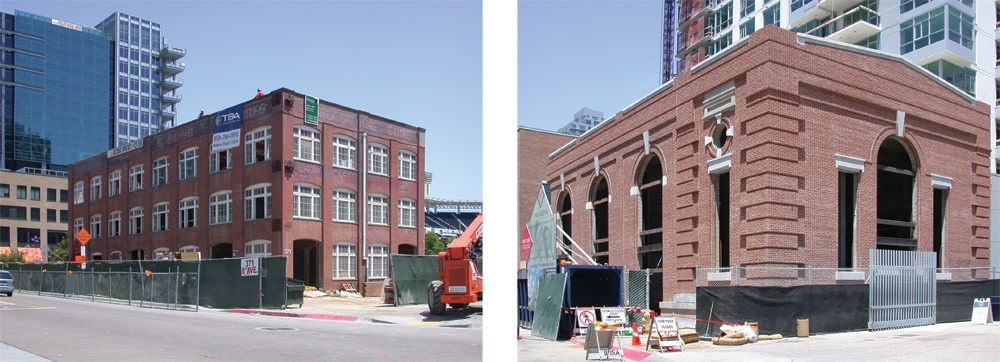
(Left) Schiefer & Sons Aeroplane Co (1917) - This former parachute factory is undergoing renovations in accordance with SOHO's agreement. (Right) Station A - Reconstruction nearing completion, awaiting the installation of its original windows. This is San Diego's only Neo-Classical Powerhouse.
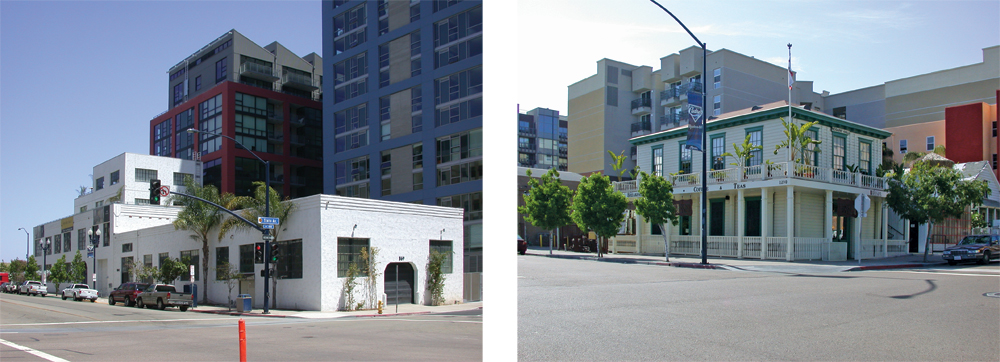
(Left) Carnation Building (1928-30) at 10th Avenue and J Street - While this building was not a part of the agreement it was covered in the design guidelines. (Right) Rosario Hall (1870) San Diego's oldest saloon and meeting house opened July 4, 1870. Moved from its original site at the foot of F Street in the 1920's to 12th Avenue in the East Village. Saved and moved once more by the SOHO agreement to the corner of 13th and J Streets.
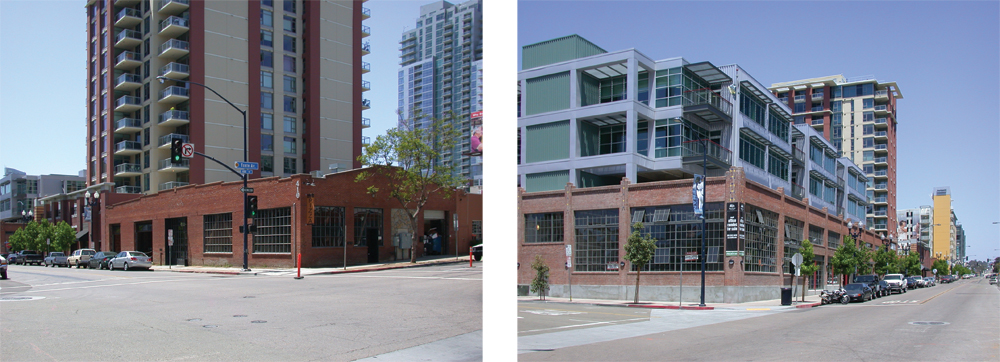
(Left) Kidd & Krone Auto Parts Building (c. 1920's) at 10th Avenue and J Street, also covered in the agreement. (Right) TR Produce building (1933) at 8th Avenue and J Street, with new addition suspended above its original clerestory roof, maintaining its original interior spaces and light.
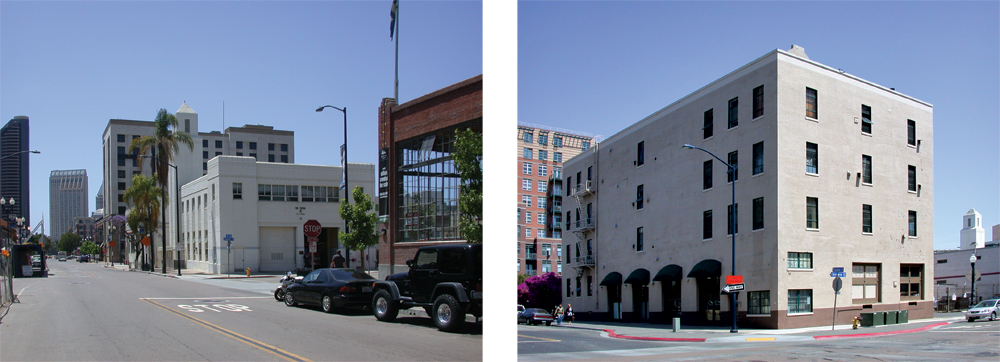
(Left) Art Deco Fire Station building (1937) built by the WPA - To be saved in its entirety. It is slated to become a restaurant as part of a separate agreement with Simplon for Cosmopolitan Square and was covered within the design guidelines for the Ballpark Agreement. (Right) Bledsoe Company Furniture Warehouse (c. 1925) to be saved in its entirety as part of the agreement with Simplon Corporation, 7th and Island Avenues.
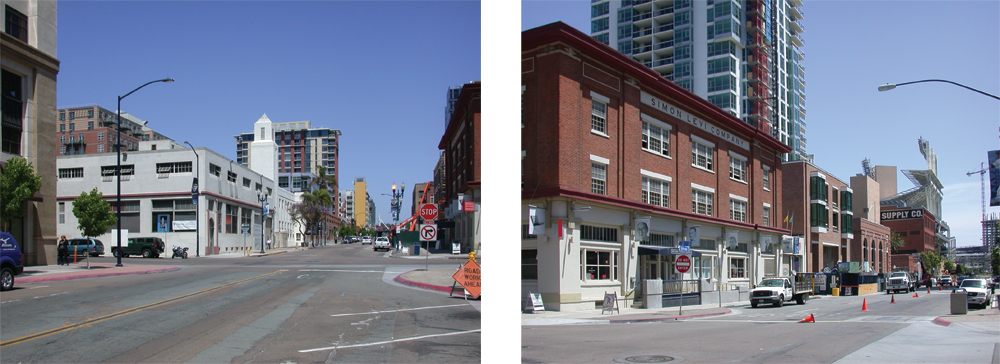
(Left) Western Wholesale Drug Company Warehouse, (1927) - Front half of building to be incorporated into the Simplon Cosmopolitan Square, 7th Avenue and J Street. (Right) New buildings interspaced with the historic 7th Avenue looking Southeast from J Street - left to right Simon Levi building (1916) preserved in its entirety, new infll, Station A reconstruction, Farmer's Bazaar and Western Metal Supply building (1909).
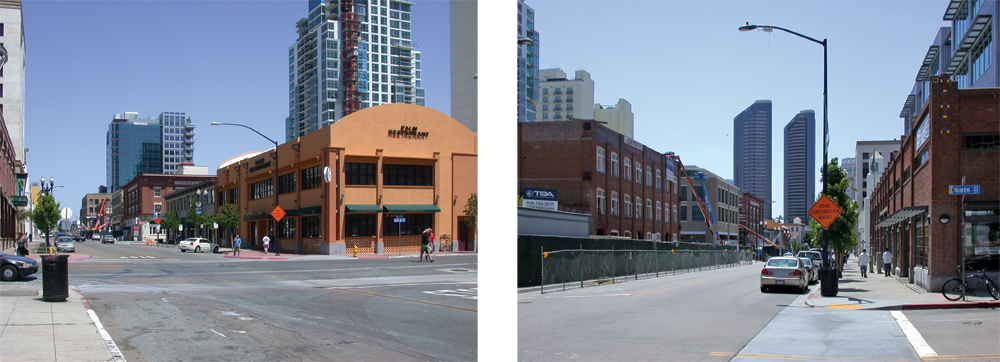
(Left) View looking east on J Street from 6th Avenue, shows the result of preserving the historic buildings and the effect of the design guidelines on the new buildings interspersed among the existing historic resources. (Right) View looking west from 9th Avenue to J Street. New infill according to the guidelines on the left in the middle.
The agreement has specific plans approved by SOHO for the rehabilitation of each building. These plans were developed by working with the public and private entities. The agreement also created an ongoing Preservation Advisory Group (PAG), which oversees the implementation of these plans.
Our agreement also contains design guidelines for new in fill development. You can see how well these guidelines are working when you look down J Street from either 6th looking east or from 12th to the West and see how the new buildings compliment the old. The agreement's various requirements for detail, rhythm, scale, fenestration, respect of the historic street grid and setbacks create an inviting, pedestrian friendly and historic area. Contrast this with the streetscape just one block north looking east from the corner of 11th and Island. While these projects might have looked OK on paper (unlikely), together they become a monolith, uninviting and monotonous.
We know that the reuse of so many historic resources in this area will be the key catalyst to ensuring economic viability and sustainability of the East Village though the normal periods of advance and decline in the real estate market. This has already been proven in the early 1990's when the only projects that were sold downtown had a historic component to them. If properly handled the Historic Warehouse District is the natural extension of the vibrant Gaslamp Quarter. The Gaslamp Quarter historic district was also a project in which SOHO led the effort to create, while under extreme opposition from property owners. Those same owners today are happy to claim it as their own idea and that's as it should be as success has many fathers when pride of place and personal ownership in the greater community sense comes into play.
This outstanding success should be used as a model, however, there is still one important part of the agreement which is not going as well as it should and that is the creation of the formal historic warehouse district. The application was supposed to have gone before the local, State and National commissions for designation consideration years ago, but local officials have been dragging their feet due to opposition from a few property owners. This, when most of the buildings are already designated or are deemed eligible as individual historic structures. This is strange considering the fact that district designation is in the best economic interest of the property owners, the entire downtown community, and for the city.
As with the Gaslamp Quarter, in time it will be the same with the Warehouse District. After all, why would anyone go to East Village except to see and experience a historical destination like no other? The historic buildings are the only draw; they are the key to redevelopment. Without these buildings being rehabilitated and reused, East Village belongs and forever will belong only to the homeless.
This is especially frustrating, as we have been working over eight years, in effect, to make these same property owners a lot of money. It is a key marketing tool for businesses to be able to say that they are located in San Diego's Historic Warehouse District. This in turn will foster the proper care of and ensure the continued preservation of the historic structures, while providing the right frame of mind for enhancing the special characteristics of this historic area, and while stimulating sensitive new development.
Don Rypkema had many important things to say and was most emphatic as he stated, "I typically visit 100 downtowns a year of every size in every part of the country. But I cannot identify a single example of a sustained success story in downtown revitalization where historic preservation wasn't a key component of that strategy. Not a one. Conversely, the examples of very expensive failures in downtown revitalization have nearly all had the destruction of historic buildings as a major element. That doesn't mean, I suppose, that it's not theoretically possible to have downtown revitalization and no historic preservation, but I haven't seen it, I haven't read of it, I haven't heard of it."
All in all, the process has been very rewarding and successful, even with the many years and the investment of hard work. The individual choices that were made here for the various historic resources will best be judged by others over time, but today we are very proud of how much we were able to save of ten of the eleven historic buildings in and around the Ballpark and many more in the surrounding area when originally nothing was to be left in the wake of the Ballpark development. SOHO has significantly and profoundly shaped the future of Downtown with the preservation of its architectural heritage ensuring the retention of a uniquely recognizable San Diegan identity. |
MORE FROM THIS ISSUE
The Broadway Fountain
San Diego's Historic Warehouse District
Just the Facts
National City & Otay Railroad Depot
The Inside Story
2007 Most Endangered List
Sim Bruce Richards
2007 People In Preservation Award Winners
Baseball Returns Downtown
Reflections
Lost San Diego
Strength in Numbers
Advertisements
DOWNLOAD full magazine as pdf (24mb)
|











